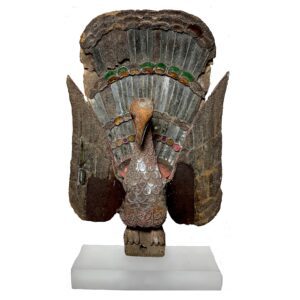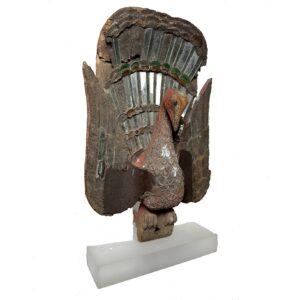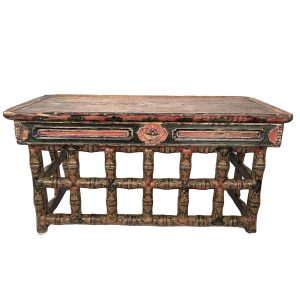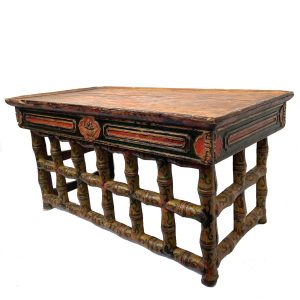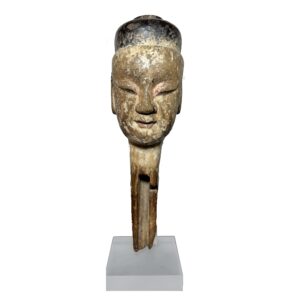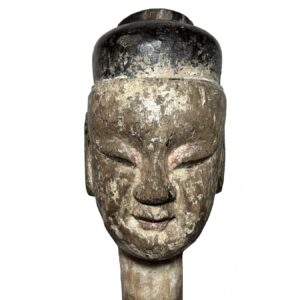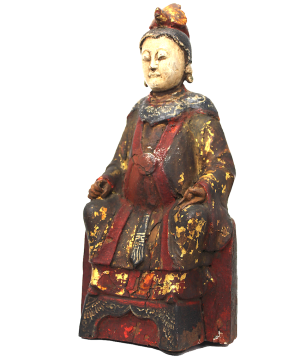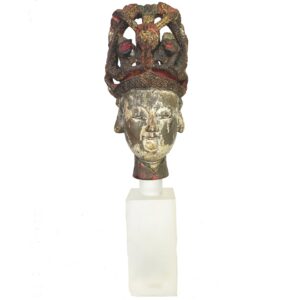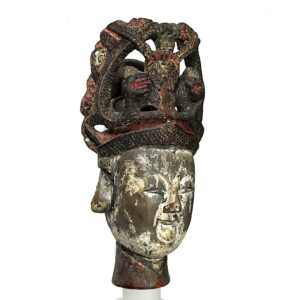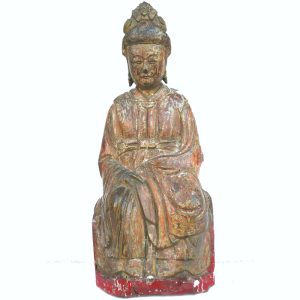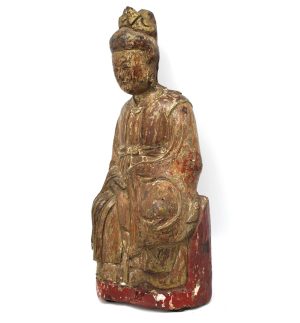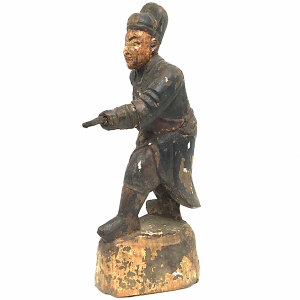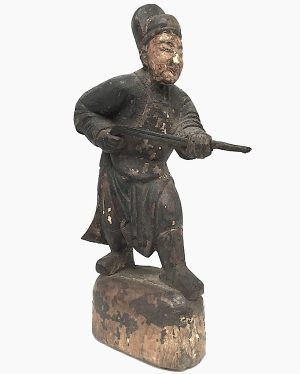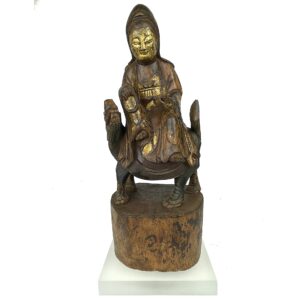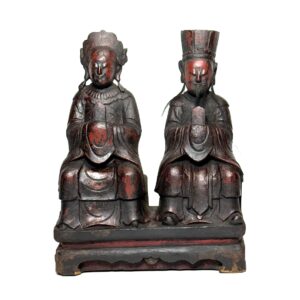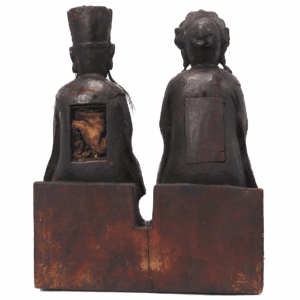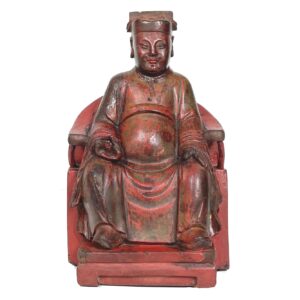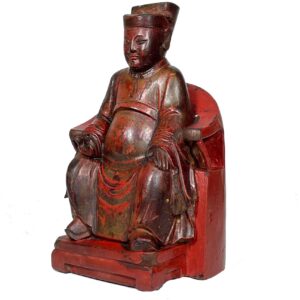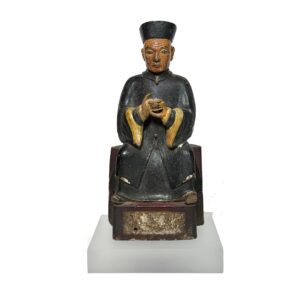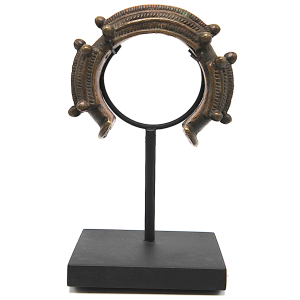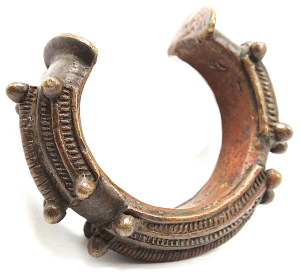Showing 73–84 of 200 results
-
Sale!


$725.00 Original price was: $725.00.$595.00Current price is: $595.00.
H: 16.5” W: 9.5” | 2.875” : | CALL 213-568-3030 OR EMAIL [email protected] FOR SHIPPING.
Carved Mandalay style peacocks with outspread feathers like this were placed over entrances to protect religious and government buildings. The peacock was emblem of last Burmese Dynasty symbolizing the monarchy descending from the sun.
-
Sale!


$750.00 Original price was: $750.00.$550.00Current price is: $550.00.
Ht: 13.75” W: 26.25” D: 13.125” | FOR SHIPPING INFORMATION CAL 213-568-3030 OR EMAIL [email protected]
One of a pair of Tibetan antique folding traveling prayer/study table for monks or nomadic families to lay out sutras (scriptures), scrolls, books, other study materials. Decorated with painted florals and fruit offering bowl symbolizing flowering of enlightenment and opening of the heart.
-
Sale!


$495.00 Original price was: $495.00.$395.00Current price is: $395.00.
Ht: 22.25” W: 7.25” D: 5” | FREE SHIPPING WITHIN CONTINENTAL U.S.
This detailed male puppet head with a calm expression, round bun and half-smile was very versatile, used in religious or secular performances. Changing costumes and headgear, it could have been a Buddhist, Taoist or Popular Religion figure or deity or non religious character.
-
Sale!


$585.00 Original price was: $585.00.$395.00Current price is: $395.00.
H: 11.5″ W: 5.3″ D: 4.2″ | FREE SHIPPING WITHIN CONTINENTAL U.S.
Provincial carving with iconic phoenix headdress, hands in karana mudra to cast out demons, negative energy and purify spaces. Image was on home altar and consecrated with a sealed cover.
-
Sale!


$785.00 Original price was: $785.00.$495.00Current price is: $495.00.
Ht: 17” W: 4.25” D: 4.5” | FREE SHIPPING WITHIN CONTINENTAL U.S.
Very rare depiction of Queen Mother of the West puppet head wearing elaborate headdress with outstretched tortoise legs atop a phoenix, reflecting early shamanism rites of turtle shell divination. Mounted on acrylic base.
-
Sale!


$525.00 Original price was: $525.00.$295.00Current price is: $295.00.
H: 11.25″ W: 4.6″ | 3.25″ FREE SHIPPING WITHIN CONTINENTAL U.S.
Dense hardwood Queen Mother carving with phoenix in crown, holding robe across body, calmly seated on backless throne, much original polychrome and lacquer finish remains. Sealed consecrated cavity.
-
Sale!


$315.00 Original price was: $315.00.$275.00Current price is: $275.00.
H: 9 ” W: 3.625″ D: 3.5 ” | FREE SHIPPING WITHIN CONTINENTAL U.S.
Unique ancestor figure of a huntsman in the round standing on a domed pedestal, holding a flint lock, wearing a hunting coat, a two-level hat, traditional under- and outer-garment, and thick boots.
-
Sale!


$725.00 Original price was: $725.00.$585.00Current price is: $585.00.
H: 15.125” W: 6” D: 5” | FREE SHIPPING within Continental U.S.
Rare provincial carving of Guanyin in lalitsana clasping a rosary on a mythical Hǒu that symbolizes righteousness, morality and ushers in peace and prosperity. Small yet powerful, consecrated and mounted on Acrylic base.
-
Sale!


$995.00 Original price was: $995.00.$695.00Current price is: $695.00.
H: 10″ W: 7.75″ D: 8.25″ | FREE SHIPPING WITHIN CONTINENTAL U.S.
Rare single image of Kitchen God and wife, indicating their close/lasting relationship as family’s protectors. Detailed elaborate officials’ robes, headgear. Individually portrayed holding hu tablets like those held by high court officials or Taoist priests.
-
Sale!


$650.00 Original price was: $650.00.$385.00Current price is: $385.00.
H: 7.25” W: 4.625” D: 3.5” | FREE SHIPPING WITHIN CONTINENTAL U.S.
Finely carved ancestor displaying status symbols: official’s attire and hat, horseshoe chair with feet on pedestal. Painted and lacquered front and back in red, traces of gilt, colors of “fu” as a wish for wealth, health and long life, aged from years of use into a great patina.
-
Sale!


$675.00 Original price was: $675.00.$495.00Current price is: $495.00.
Ht: 9″ W: 5″ D: 3.5″ | FREE SHIPPING WITHIN CONTINENTAL U.S.
Masterfully crafted Taoist official with calm, sincere and expressive face with creases indicating his age and wisdom of his senior status. Holds ritual cup with the elixir of immortality, a wish for a long and happy afterlife. Mounted on an acrylic stand.
-
Sale!


$295.00 Original price was: $295.00.$210.00Current price is: $210.00.
H: 3.125” W: 4” Thick: 1.125.5” Circum: 9.5” | FREE SHIPPING WITHIN CONTINENTAL U.S.
Heavy antique exquisite C-shaped Senufo manilla, divided into ornate sections, deeply carved, pairs of raised round metal pieces. Fine patina with wood and metal stand.
End of content
End of content

